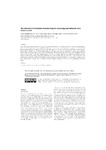The Cave Bear’s Hibernation: Reconstructing the Physiology and Behaviour of an Extinct Animal

Use este enlace para citar
http://hdl.handle.net/2183/34730
A non ser que se indique outra cousa, a licenza do ítem descríbese como Atribución-NoComercial 4.0 Internacional
Coleccións
- Investigación (FCIE) [1227]
Metadatos
Mostrar o rexistro completo do ítemTítulo
The Cave Bear’s Hibernation: Reconstructing the Physiology and Behaviour of an Extinct AnimalData
2018-05-02Cita bibliográfica
Aurora Grandal-d’Anglade, Marta Pérez-Rama, Ana García-Vázquez & Gloria María González-Fortes (2019) The cave bear’s hibernation: reconstructing the physiology and behaviour of an extinct animal, Historical Biology, 31:4, 429-441, DOI: 10.1080/08912963.2018.1468441
Resumo
[Abstract] When studying an extinct species such as the cave bear (Ursus spelaeus ROSENMÜLLER 1794), it is possible to apply a variety of molecular biology techniques such as the study of stable isotopes or mitochondrial DNA (mDNA) to infer patterns of behaviour or physiology that would otherwise remain concealed. Throughout Europe and along time, differences in the isotopic values (δ13C and δ15N) of cave bears arise from environmental differences and the Pleistocene climatic evolution. The climate determines the hibernation length, during which the cave bears undergo a particular physiology that can be related to an increase in δ15N during climate cooling. In order to verify whether hibernation affected the isotopic values, we compared cave bears in different ontogenetic stages. The results show that perinatal values reflect the values for mothers during hibernation, while juveniles show differences in maternal investment. A previous study in the literature based on complete mitochondrial DNA sequences of several individuals collected from closely situated caves showed that each cave housed, almost exclusively, a single lineage of haplotypes. This pattern suggests extreme fidelity to the birth site, or homing behaviour, and that cave bears formed stable maternal social groups, at least for the purpose of hibernation. Studies of this type offer unexpected data on the palaeobiology of this extinct animal.
Palabras chave
Ursus spelaeus
Metabolism
Stable isotopes
Ancient DNA
Homing behaviour
Metabolism
Stable isotopes
Ancient DNA
Homing behaviour
Descrición
This is an Accepted Manuscript version of the article, accepted for publication in Historical Biology.
Versión do editor
Dereitos
Atribución-NoComercial 4.0 Internacional
ISSN
1029-2381






